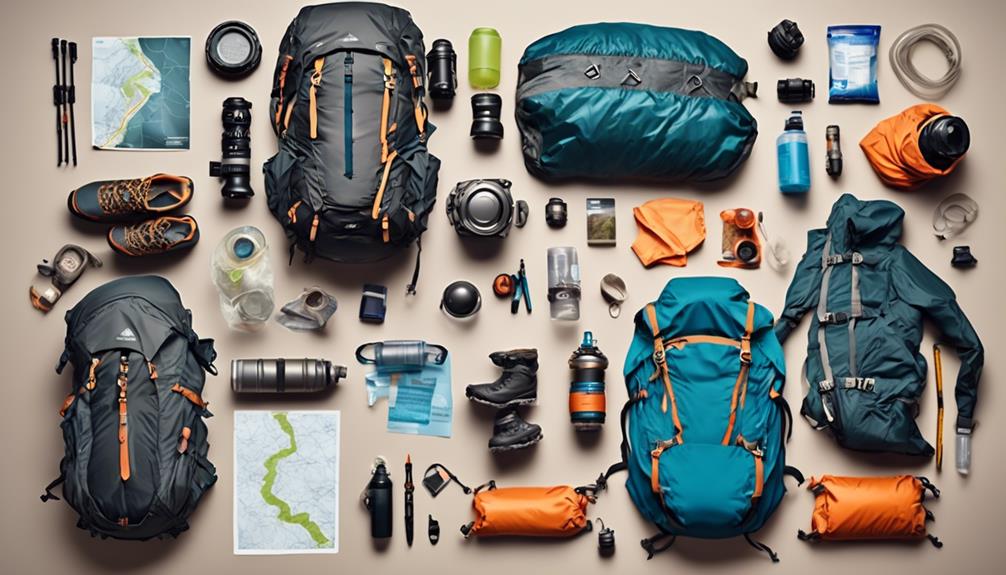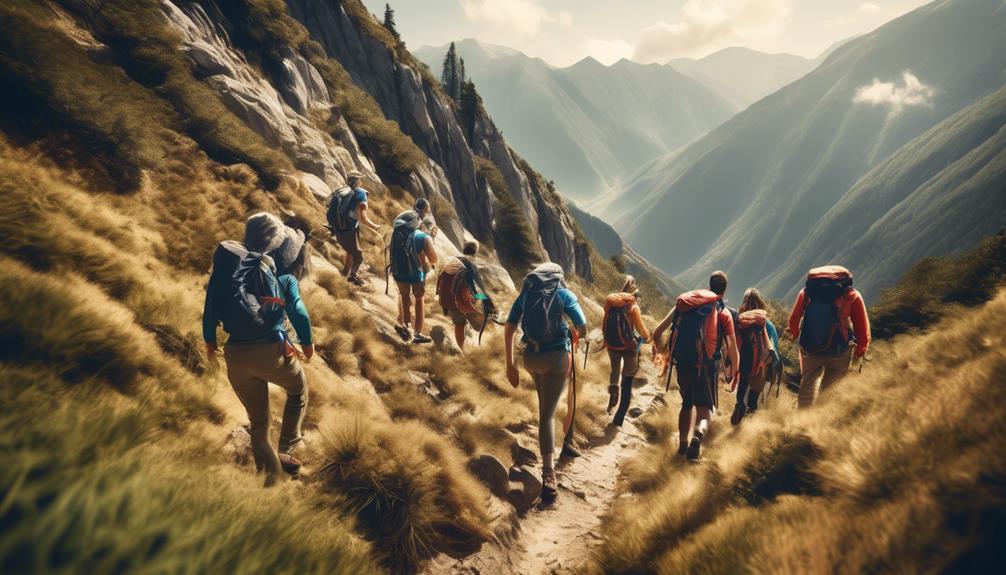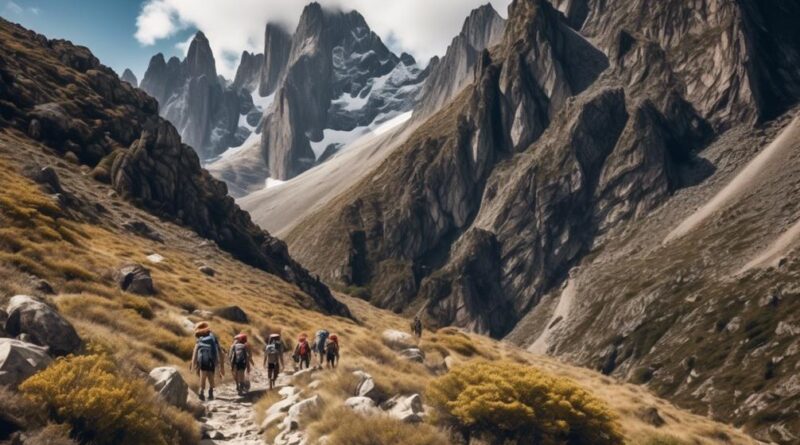Exploring Guided Group Mountain Trekking Tours
When it comes to exploring the world of guided group mountain trekking tours, it's like embarking on a journey into the heart of nature's grandeur. The thrill of conquering rugged peaks, the camaraderie of fellow adventurers, and the guidance of seasoned experts create an experience that goes beyond mere sightseeing.
But before you lace up your boots and hit the trails, there are crucial considerations to ponder and preparations to be made. From choosing the right tour company to mastering essential gear, the path to an unforgettable mountain trekking adventure awaits.
Benefits of Guided Group Tours
Joining a guided group trekking tour can enhance your outdoor experience by providing expert leadership and a supportive community of fellow adventurers. The social interaction and camaraderie you'll experience on a guided group trekking tour are invaluable. As you conquer challenging trails and breathtaking summits together, you'll forge bonds with like-minded individuals who share your passion for adventure. Sharing the triumphs and struggles of the journey creates a sense of camaraderie that's hard to replicate when trekking alone. The friendships formed during these tours often extend beyond the trek itself, leading to lasting connections with people who understand and appreciate the thrill of outdoor exploration.
Additionally, the personalized guidance and support offered by experienced tour leaders can significantly enhance your trekking experience. These leaders possess in-depth knowledge of the terrain, local culture, and wildlife, enriching your journey with valuable insights. Their expertise ensures that you can focus on enjoying the trek while they handle navigation, safety, and logistics.
Moreover, having a support system in place can be crucial, especially during challenging sections of the trek. Whether it's offering encouragement during steep ascents or providing assistance with gear, the presence of knowledgeable guides and a supportive group can make a world of difference in your trekking adventure.
Choosing the Right Tour Company
When selecting a tour company for your guided group mountain trekking experience, it's essential to thoroughly research and compare the available options to ensure a memorable and well-organized adventure.
Begin by evaluating tour companies based on customer reviews. Look for testimonials and feedback from previous participants to gauge the overall satisfaction and experiences. This will provide valuable insights into the quality of service, safety measures, and the overall reliability of the tour company.
In addition to customer reviews, delve into the qualifications and experience of the tour guides provided by each company. A knowledgeable and experienced tour guide can greatly enhance your trekking experience by offering valuable insights, ensuring safety, and providing an in-depth understanding of the terrain and local culture. Look into the certifications, training, and experience of the guides to ensure that they're well-equipped to lead groups through the mountain trails.
Moreover, consider the track record of the tour company in organizing mountain trekking tours. A company with a proven history of successful and well-organized treks is more likely to provide a seamless and enjoyable experience. Research their itineraries, safety protocols, and the overall support provided throughout the trekking journey.
Essential Gear for Mountain Trekking

As you prepare for your guided group mountain trekking adventure, ensuring you have the essential gear is crucial for a safe and enjoyable experience. Gear selection plays a vital role in helping you navigate the various mountain challenges you may encounter. Here are some essential items to consider packing for your trek:
- Sturdy Hiking Boots: Invest in high-quality, properly fitted hiking boots to provide ankle support and traction on rugged terrain. Ill-fitting footwear can lead to discomfort and blisters, which can quickly turn a pleasant trek into an arduous journey.
- Weather-Appropriate Clothing: Dressing in layers is key for mountain trekking, as weather conditions can change rapidly. Pack moisture-wicking base layers, insulating mid-layers, and a waterproof, breathable outer shell to stay comfortable in diverse conditions.
- Navigation Tools: Carrying a map, compass, or GPS device is essential for staying on track during your trek. Mountains can present challenging terrain, and having the right tools to navigate ensures you stay on course.
- Hydration and Nutrition: Pack sufficient water and energy-boosting snacks to sustain your energy levels throughout the trek. Dehydration and lack of fuel can quickly lead to fatigue and diminish your ability to tackle mountain challenges effectively.
Training and Preparation Tips
Prepare for your guided group mountain trekking adventure by focusing on training and preparation tips to enhance your experience.
Training techniques are crucial to ensure you have the physical stamina to tackle the varying terrain and elevation changes. Incorporate hiking into your regular exercise routine to build endurance and strengthen your leg muscles. Additionally, practice carrying a weighted backpack to simulate the conditions you'll encounter during the trek. Gradually increase the weight to prepare for the demands of the journey.
Mental preparation is equally important. Visualize yourself successfully navigating the trails and overcoming any obstacles that may arise. Develop a positive mindset and cultivate mental resilience to push through challenging moments. Consider practicing mindfulness or meditation to help stay focused and calm during the trek. Engage in activities that promote mental clarity and stress reduction, such as yoga or deep breathing exercises.
Incorporating interval training into your workouts can also be beneficial. This involves alternating between bursts of intense activity and periods of lower intensity or rest, mimicking the pace of mountain trekking. It helps improve cardiovascular endurance and prepares your body for the fluctuating intensity of the trek.
Remember to listen to your body throughout your training. Rest and recovery are essential for preventing injuries and allowing your muscles to repair and strengthen.
Best Destinations for Group Trekking

To further your mountain trekking preparations, it's crucial to choose destinations that offer a diverse range of trails and scenic landscapes for group trekking adventures. When selecting the best destinations for group trekking, consider the following factors:
- Popular routes: Opt for destinations that feature popular trekking routes, as these paths are well-maintained and often offer a sense of camaraderie as you encounter fellow trekkers along the way. Popular routes also tend to have more amenities and support services, making them ideal for group excursions.
- Spectacular landscapes: Look for destinations that boast breathtaking landscapes, such as towering mountain peaks, lush valleys, serene lakes, and cascading waterfalls. The visual splendor of these locales won't only enhance your trekking experience but also provide ample opportunities for group photos and shared memories.
- Varied terrain: Seek out destinations with diverse terrain, including forested trails, rocky paths, alpine meadows, and rugged terrain. Trekking through varied landscapes adds an element of excitement and challenge to the journey, keeping the adventure dynamic and engaging for the entire group.
- Cultural immersion: Consider destinations that offer opportunities for cultural immersion, where you can interact with local communities, learn about indigenous traditions, and savor authentic cuisines. This enriching experience adds a unique dimension to the trek and fosters a deeper appreciation for the destination.
Safety Measures and Guidelines
When trekking in a group, always prioritize safety by familiarizing yourself with the recommended measures and guidelines for the journey. Before embarking on a guided group mountain trekking tour, it's crucial to understand the emergency procedures and communication protocols established by the tour guides. Familiarize yourself with the designated meeting points, emergency signals, and communication devices that will be used in case of unforeseen circumstances. Additionally, ensure that you're aware of the risk assessment and contingency planning that has been put in place by the tour organizers.
This includes understanding the potential hazards of the trek, such as extreme weather conditions, difficult terrain, and wildlife encounters. It's important to be informed about the steps that will be taken in the event of an emergency, such as injuries or extreme weather changes.
Furthermore, make sure to adhere to the safety guidelines provided by the tour guides, including staying with the group, maintaining a safe distance from cliff edges, and following the designated paths. It's essential to listen carefully to the instructions given by the guides and to ask questions if anything is unclear.
Group Dynamics and Team Building

By fostering a sense of camaraderie and cohesion within the group, collective efforts can be maximized during the mountain trekking tour. Team bonding and group communication are essential for creating a supportive and collaborative environment, enhancing the overall experience for everyone involved.
Here are some key aspects to consider for building strong group dynamics and effective team building during your mountain trekking tour:
- Active Listening: Encourage active listening among group members to ensure everyone feels heard and understood. This fosters an atmosphere of respect and empathy, strengthening the bonds within the group.
- Shared Responsibilities: Distribute responsibilities among group members, such as navigation, meal preparation, and campsite setup. This not only promotes a sense of teamwork but also allows individuals to showcase their strengths and contribute to the collective success of the trek.
- Open Communication: Create an environment where open communication is valued, allowing everyone to express their thoughts, concerns, and ideas. Clear and transparent communication helps in problem-solving and decision-making, fostering a cohesive and unified group.
- Celebrating Achievements: Recognize and celebrate individual and group achievements along the trek. Whether it's reaching a challenging summit or overcoming a tough trail, acknowledging these accomplishments strengthens the sense of unity and motivation within the group.
Environmental Impact and Responsible Trekking
As you embark on your mountain trekking tour, it's crucial to consider the environmental impact and practice responsible trekking to ensure the preservation of natural landscapes for future generations. Responsible tourism plays a vital role in minimizing the environmental footprint of trekking activities. It involves adhering to designated trails, minimizing waste generation, and respecting local flora and fauna. By staying on marked paths, you help prevent soil erosion and protect fragile ecosystems from unnecessary damage. Additionally, carrying reusable water bottles and food containers reduces the amount of single-use plastics, contributing to conservation efforts.
Conservation efforts are also integral to responsible trekking. Many mountainous regions are home to diverse and endangered species, and minimizing human impact on their habitats is imperative. Engaging in responsible trekking means respecting wildlife by observing from a distance and refraining from feeding or disturbing animals. Furthermore, supporting local conservation initiatives and community-based tourism projects can help contribute to the preservation of these natural environments.
Incorporating responsible tourism practices into your mountain trekking experience not only minimizes your environmental footprint but also supports the longevity of these captivating landscapes. By being mindful of the impact of your actions and embracing responsible trekking principles, you actively participate in the conservation of natural habitats and ensure that future generations can continue to enjoy and be inspired by the beauty of the mountains.
Frequently Asked Questions
How Do Guided Group Mountain Trekking Tours Cater to Different Fitness Levels and Abilities?
When exploring guided group mountain trekking tours, they cater to different fitness levels and abilities through adapted training, safety measures, fitness assessment, and equipment requirements. This ensures everyone can participate and enjoy the adventure.
What Are Some Common Challenges That Participants May Face During Guided Group Mountain Trekking Tours?
Some common challenges you may face during guided group mountain trekking tours include unpredictable weather conditions, physical exertion, and potential altitude sickness. It's essential to take safety precautions, such as staying hydrated and acclimatizing properly.
Are There Any Cultural or Local Customs That Participants Should Be Aware of When Trekking in Certain Destinations?
When trekking in certain destinations, be mindful of local etiquette and cultural norms. Respect local customs, such as removing shoes before entering a home or dressing modestly in religious sites. It enhances your experience and shows respect.
What Kind of Wildlife Can Be Encountered During Guided Group Mountain Trekking Tours, and How Should Participants Interact With Them?
When encountering wildlife during your trek, remain respectful and observe from a safe distance. Avoid feeding or approaching animals. Your actions impact the environment and wildlife conservation efforts. Always prioritize the well-being of the local flora and fauna.
How Do Tour Companies Ensure the Sustainability and Conservation of the Natural Environment in the Areas Where Guided Group Mountain Trekking Tours Take Place?
To ensure sustainability and conservation, tour companies minimize environmental impact through responsible tourism practices. They engage local communities in conservation efforts, supporting the natural environment and wildlife while providing enriching experiences for trekkers.
Conclusion
So, if you're looking for an adventure that combines thrilling outdoor experiences with the camaraderie of a group setting, consider joining a guided mountain trekking tour.
With the right tour company, essential gear, and proper training, you can explore stunning destinations while building lasting memories with your fellow trekkers.
Remember to prioritize safety, respect the environment, and embrace the teamwork and dynamics of group trekking for an unforgettable experience.
